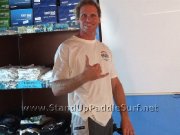Paddle Technique Part 2 – The three ingredients of a powerful stroke by Robert Stehlik
Breaking down the Power Phase
by Robert Stehlik
This is part two of the paddle technique series.
First, some recommended reading:
Good technique starts with a good paddle, so if you are not sure you have the right paddle, read part one first:
Choosing the right Paddle
A stand up paddle stroke can be broken down into these main phases: Reach, Catch, Power, Release, Recover.
Dave Kalama breaks down these steps and the Tahitian style paddle technique very well on his blog at:
www.DaveKalama.com

(click thumbnail to launch video)
Each step of the stroke is important and needs to be practiced. Good reach and catch are important before applying the power so they really should come first but for this post I will just focus on the power phase, where the pedal hits the metal. I have found an effective way of teaching a more powerful stroke is by breaking down the power phase into three basic components or ingredients, which I call PUSH, TWIST, LEAN.
Each paddler develops their own individual technique and you can often identify a friend by their stroke long before you are close enough to recognize any features. Despite different styles, I think every good paddler uses a combination of the “three ingredients”.
Beginners often paddle by pulling the paddle with the lower arm. This is the least efficient way to paddle and will tire the arms quickly. Pulling with the lower arm bent is not an ingredient of a powerful stroke. The bottom arm should always be straight throughout the power phase. The lower hand acts as the fulcrum point of the paddle. The only time the lower arm can bend is to lift the paddle out of the water for the recovery. (To visualize this motion, I like Dave’s image of pulling a sword out of it’s sheath).
To learn how to combine the “three ingredients” for maximum power, we will look at and practice each ingredient in isolation before combining them. Evan shot a video where I demonstrate the three ingredients on the paddle simulator in our shop. If the description is confusing, please watch the video and it will hopefully make sense. If you are still having a hard time, please stop by the Blue Planet shop for a paddle simulator demonstration or come to one of our monthly clinic/ demo days where we have advanced paddle technique clinics (it’s all free).
First ingredient: PUSH: This is basically using your top arm to push the paddle out in front of you. Try to do this motion in isolation while keeping your shoulders square, staying upright, and keeping the bottom arm straight. It’s like you are punching your hand forward from eye level or so. By bending the top arm, you increase the forward reach and by pushing with your top arm you can do quick strokes that work well when you want to accelerate quickly, like when catching a wave or getting on a bump. The downside is that if you use only the triceps in your arms to power yourself your arms will tire quickly.
The second ingredient: TWIST: To practice this, keep both arms straight through the stroke and stay upright, using only a twisting motion to move the paddle. Rotate your hip and shoulder forward to reach, then unwind with the shoulders following the hips. This twisting motion should be where most of the power in your stroke comes from, using the muscles in your back and core to propel yourself forward.
The third ingredient: LEAN: A word of caution: if you have lower back problems, you will want to go easy on the lean until your your back gets stronger. To isolate the lean, keep both arms straight and keep your hips and shoulders square. Straighten your body for the reach, then use your body weight and abs to lean on the paddle by bending at the waist.
If you watch some of the most powerful paddlers (for example: Danny Ching, Chuck Patterson, or Aaron Napoleon) you will notice that they lean heavily on their paddle during the stroke and often end the stroke with their upper body at an almost 90 degree angle to the legs. By pushing the blade down into deeper water during the stroke, it also reaches more “new still water” (as my swim coach likes to call it), giving it more grab. The lean adds power to the stroke but also lengthens the stroke and the recovery takes longer. Dave Kalama proved that the quick, shorter, Tahitian style stroke is very efficient in longer races like the Molokai crossing.
It is helpful to you have several options to power yourself. If your arms start to feel tired and weak, for example, you can use more twist and lean and save the push for when you need a quick spurt of acceleration.
I recommend practicing and perfecting these three ingredients in isolation, then try to combine them in different ways to find your own “secret sauce”.
For more tips from Robert, visit his Zen Waterman blog at http://zenwaterman.blogspot.com/.




thanks for that guys!
Great tips! I’ve been using these tips on early takeoffs. Really helps!
[..YouTube..] very nice instructional. Only been out on my sup 3 times….alll paddling completely wrong. Still fun, though.
Really very useful, I will try your way in practice, thank you